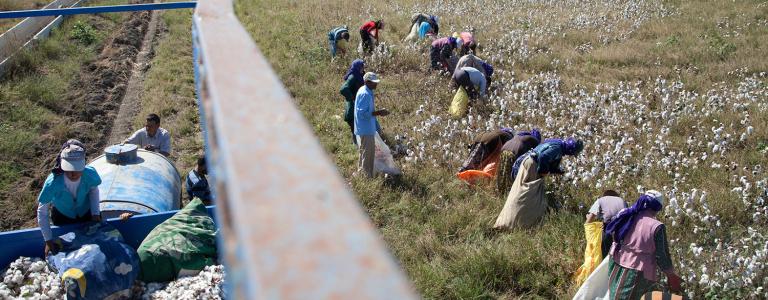From Cotton Ginner to Retail Rack: How much do we really know about “sustainable” cotton?
Exploring the complex value chains behind our t-shirts and towels and asking why we need to get better at tracing garments from the store back to the farm.
Cotton. Once a wild perennial plant, it is now a trillion-dollar industry.
As the most common natural fibre in the textile industry, cotton is used for a wide range of purposes—from clothing and upholstery to hygiene products and medical equipment.
But hidden behind our t-shirts and towels are over 100 million households in 75 countries that rely on cotton cultivation for a living. Nine out of 10 of these households are in lower-income countries. And they are grappling with challenges such as water scarcity, pest management, and low prices and incomes.
Voluntary sustainability standards (VSSs) such as Better Cotton, Organic, and Cotton made in Africa seek to address these challenges. They set sustainability requirements for cotton farmers and processors to meet in exchange for certifying their produce as VSS compliant, which can help them fetch up to 50% higher prices.
VSS-compliant cotton production has doubled every 2.5 years since 2008 and now accounts for at least a quarter of global cotton production. This form of recognition can help consumers make more responsible purchasing choices. But how much do we really know about “sustainable” cotton?
A lack of transparency in cotton textile value chains is hindering VSSs’ impact. By the time a garment reaches the retail rack, much of the information about where and how it was produced is lost. Where did the cotton come from? What price was paid to the farmer? What environmental and socio-economic impacts were generated? Did all stages of its processing comply with a VSS?
To help answer these questions, IISD partnered with fashion retailer Kappahl to map the value chain for select organic cotton garments. We mapped the identities, locations, and operations of upstream suppliers. And we engaged with them to collect sustainability data.
This mapping could help Kappahl address concerns and make more informed decisions when purchasing from suppliers. It may also help them to verify organic certification and disclose more reliable sustainability information to their customers.
If you’re interested in learning more, check out our research:
You might also be interested in
Global Market Report: Tea prices and sustainability
This report explores recent market trends in the tea sector and explains why we need to get better at recognizing the social and environmental costs of tea production.
Producer Inclusion in Voluntary Sustainability Standard Governance
This report analyzes the extent to which producers are included in the governance of agricultural standards and recommends ways for standard-setting organizations to give producers opportunities to help steer their course.
South-South Trade and Voluntary Sustainability Standards
This report explores how voluntary sustainability standards are being used in trade policy to increase the trade of more sustainable products between developing countries.
Global Market Report: Sugar cane prices and sustainability
This report explores recent market trends in the sugar cane sector, what these trends mean for producers in developing countries, and what can be done to improve farmers' incomes.
